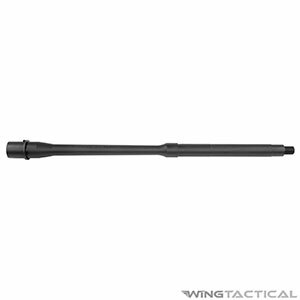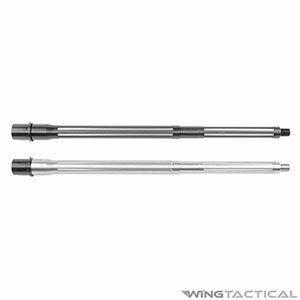Choosing the right barrel for your AR-15 is crucial to getting the most out of your firearm, as every detail of your barrel directly impacts its performance. At Wing Tactical, we want to help you pick out the best barrel for your rifle, regardless of whether you choose a 5.56 barrel or a .223 barrel. We welcome you to take a closer look at our options available here and invite you to learn more about the differences between these two types of barrels so that you can order the right one for your AR-15.

What Are the Differences Between a 5.56 Barrel and a .223 Barrel?
At first glance, a 5.56 barrel and a .223 barrel for an AR-15 might look almost identical to the naked eye. The 5.56 NATO and .223 Remington barrels are both popular options thanks to their flat trajectories, high velocities, and limited recoil. But 5.56 and .223 barrels are not interchangeable. Barrels with these chamberings have some significant differences that can impact safety, performance, and functionality. For example, the 5.56 NATO barrel produces more pressure and has a longer throat than the .223 Remington barrel. That’s why you need to select the right barrel for an AR-15 with the help of Wing Tactical.

5.56 Barrel
5.56 NATO cartridges have higher pressure levels of 58,000 pounds per square inch (psi). The higher pressure ensures rounds fire dependably and pushes a stable projectile with minimal fuss in various conditions. It’s a common military choice but has also gained popularity for home defense.

.223 Barrel
.223 cartridges have lower pressure levels of about 55,000 psi. The barrel also has a shorter throat compared to a 5.56. A .223 has a high velocity, flat trajectory, and lighter recoil. It is a popular choice for competitive sport shooters.
Wing Tactical: The Best Barrels for AR-15s
Wing Tactical is a veteran-founded company that has been supplying civilian gun owners, first responders, active-duty military members, and competitive shooters with firearm parts and accessories for over a decade.
When you find yourself in the market for a 5.56 barrel or want to discover more about the benefits of using .223 barrels, you can rely on Wing Tactical to get you what you need. We sell barrels for AR-15s from a wide range of reputable brands, and our team of experts can help you choose which barrel will work best with your AR-15.
It doesn’t matter if you’re building your first AR-15 from scratch or looking to upgrade a rifle you’ve owned for years now. Wing Tactical can set you up with the necessary barrels and other parts. Get in touch with us today to place an order and enjoy fast shipping.
Frequently Asked Questions
Can I use the same ammunition in 5.56 and .223 barrels?
You can shoot both .223 and 5.56 ammo safely from a 5.56 chamber, but shooting 5.56 ammo from a .223 Rem. chamber can result in catastrophic rifle damage and potentially harm the shooter.
If you fire 5.56 ammo from a .223 Rem. chamber, the primer will likely blow out, damaging the firearm or blocking moving parts as the action tries to cycle. The hotter 5.56 load also causes case expansion that can be problematic in the tighter .223 Rem. chamber. This case expansion can cause extraction failures and damage the upper receiver in extreme instances.
Which is better for my AR-15?
Whether a 5.56 or .223 barrel is better for your rifle depends largely on how you plan to use your AR-15. If you want to get into handloading and pursue maximum accuracy, the .223 will likely serve you best. For those who plan to spend long hours on the range and like to save money by buying bulk ammunition, it's hard to beat a 5.56.
Want to keep your options open? A .223 Wylde barrel can fire both rounds while maintaining accuracy.
Which brands sell the best barrels?
At Wing Tactical, we offer .223 and 5.56 barrels from many of the most trusted names in the firearms industry. These brands include Ballistic Advantage, Aero Precision, Faxon Firearms, Strike Industries, and more. Rest assured, if you see it on our site, we’d be comfortable using it ourselves.
Will I be able to install barrels on my own?
If you feel comfortable working with firearm parts and adding them to your AR-15, installing these barrels on your rifle won’t be too difficult. You’ll also always have the option to take your rifle to a gunsmith to have them put it in place if you would like.






